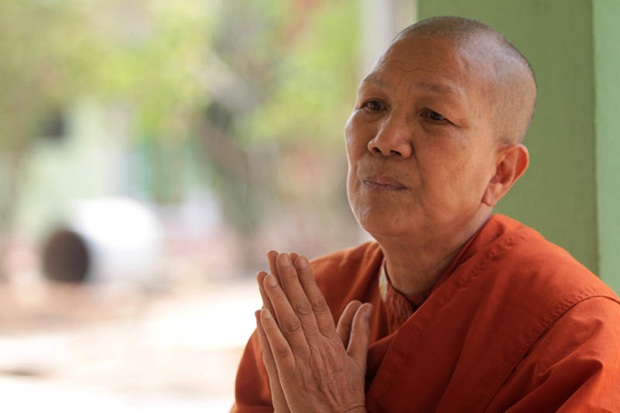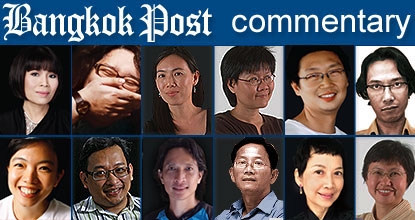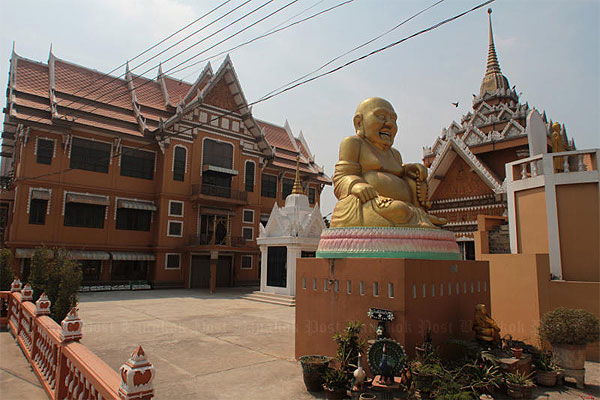
Dhammananda Bhikkhuni, an abbess at Songdhammakalayani Monastery, is on a mission: she wants to “build up a bhikkhuni sangha [female monkhood] in Thailand”.
But amid intense opposition, that goal, inscribed in stone at the entrance to her monastery in Nakhon Pathom province, is not going to happen overnight.
“Some think that the lineage of bhikkhuni sangha in Thailand has died out, full stop. But I would like to change that into a comma,” the 70-year-old monk told Spectrum.
With a clean-shaven head and dressed in saffron robes, Dhammananda lives the life of an ordinary monk, beginning her day with early morning prayers before walking with other bhikkhunis to a nearby village to receive alms.
But she, along with other female monks, has been outcast by the Supreme Sangha Council, Buddhism’s governing body in Thailand, which prohibits monks under its jurisdiction from ordaining bhikkhunis.
“It is not a question of whether we should or shouldn’t allow the ordination of women. But it is not permissible under the dhamma vinaya [monastic rules],” said Phra Tepvisutthikawee, the abbot of Wat Rajadhives Viharn and secretary-general of the Buddhism Protection Centre of Thailand.
BOUND BY TRADITION
The reasoning offered by the Supreme Sangha Council essentially boils down to the fact that, under Theravada Buddhist principles, a female monk must be present to ordain a new bhikkhuni.
But because the bhikkhuni lineage in Thailand has ended — or, more likely, never existed — there is no way for a female monk to be present during the ordination ceremony.
Dhammananda, however, believes the right for females to be ordained is enshrined in Buddha’s teachings.
“The Lord Buddha established four-folded Buddhism, consisting of bhikkhu sangha [male monks] and bhikkhuni sangha together with laymen and laywomen,” she said.
“It means that female monks are meant to be one of the four legs. That has been very clear from the beginning. But now we are sitting on a three-legged chair.”
Phra Tepvisutthikawee said he accepted that the existence of female monks was recognised in the Tripitaka, Buddhism’s holy text. But he said the lineage of Thevarada female monks was thought to have been lost for more than a thousand years.
“Since the lineage was lost, there are no longer any bhikkhuni to ordain female monks,” he said.
‘I HAD TO DO MORE’
For Dhammananda, the mission to restore Thevarada female monks in Thailand runs in her blood. Her grandmother was a mae chi, or white-robed nun, at a temple in Bangkok. The two never met — her grandmother died one year before she was born.
But Dhammananda’s mother, Voramai Kabilsingh, also followed a similar path, beginning her monastic life by receiving the eight precepts from Phra Prommuni, of Wat Bavornnives.
However, frustrated by her inability to become a fully-fledged monk in the Theravada tradition, Voramai instead became ordained as a monk in the Mahayana sect in Taiwan in 1971.
The Mahayana sect, popular in North Asia, is considered more liberal than its Thevarada counterpart, which dominates Sri Lanka and most of Southeast Asia.
Dhammananda, who was born Chartsumarn Kabilsingh, recalled the moment when she saw her mother shave her head at the temple, saying she “felt shy walking behind her, and people would look at me”.
In 1957, Dhammananda was ordained as a novice nun for 47 days during her summer holidays. She recalled that, at age 13, she was reluctant to go back to school with a shaved head, afraid of what her friends and classmates would say. But there was no need to be apprehensive; instead of being bullied, Dhammananda “was welcomed by my classmates”.
Dhammananda later earned a bachelor’s degree in philosophy from Visva-Bharati University in India, before continuing her studies with a master’s degree in religion from McMaster University in Canada. She later returned to India to complete her PhD in Buddhism at Magadh University.
Dhammananda then worked as a lecturer at Thammasat University’s department of philosophy and religion for more than 30 years, raising her children and enjoying life as a layperson.
But her passion for the topic of women in the monkhood never dimmed, feeding heavily into her studies and research. She steadily built connections with people of similar views, and as a religious scholar was invited regularly to give speeches internationally.
The turning point, she said, came in 1983 when she was invited by Harvard University to attend a meeting on “Women, Religion and Social Changes”.
“I met people with the same passion and I thought that it was not enough for me to only advocate,” she said. “I had to do more. I had to get myself involved.”
ENLIGHTENED PATH
Dhammananda began producing newsletters to connect women “who were hiding here and there” with a passion to promote bhikkhuni. She was actively involved in the first conference of the Sakyadhita, or the daughters of Buddha, group in Bodhgaya, India in 1987.
In 2000, Dhammananda made the decision to enter the monkhood. But, forbidden from becoming ordained in Thailand, like her mother she was forced to look abroad.
She took her initial vows with Fo Guang Shan, a revered monk in Taiwan, before travelling to Sri Lanka, where, in 2003, she became the first Thai woman to receive full ordination as a Theravada monk.
“My mother was upset when I told her that I had not become ordained for her, that I had instead ordained to promote Buddhism,” Dhammananda said. “If we are ordained for someone, our mission is over when that person dies. But if we are ordained for Buddhism, the mission lasts forever.”
Since then, Dhammananda has campaigned actively to legitimise female monks in Thailand. She later became the abbess of Songdhammakalayani Monastery in Nakhon Pathom, which was established in 1960 by her mother. It is the first monastery in the country to house only fully-ordained female monks. Today, there are seven bhikkhunis, two novices and three intermediate-level novices who will soon be ordained.
Surrounded by a serene landscape, the monastery hall features 13 statues of female arahats, or people who have attained enlightenment, each bearing an inscription detailing that arahat’s life.
Female monks wear yellow robes and follow 311 precepts — similar to the Christian Commandments — while male monks follow 227 precepts. Mae chi, or nuns, meanwhile take only eight precepts, while laypeople follow five.

Follow the rules: Phra Tepvisutthikawee, secretary-general of the Buddhism Protection Centre of Thailand.
STOKING CONTROVERSY
Debate flared over the issue of female ordination on Nov 29 last year after a ceremony at Thippayasathandhamma Bhikkhuni Arama, a nunnery in the southern province of Songkhla.
To avoid the Supreme Sangha Council’s ban, the organisers invited Sri Lankan monks to lead the ordination of eight Thai women.
At the ceremony, Dhammananda was also named a pavattini, or teacher, of the bhikkhuni candidates. That qualification would, if endorsed by the Sangha Council, effectively restore the bhikkhuni lineage and allow for the ordination of women by Thai monks.
Being a pavattini is an important part of the ordination process for women, as this “teacher” will lead the purification process, which includes asking 24 questions. If the candidate can answer all these questions, which relate to parts of the female anatomy, she will then be ordained by male monks, Dhammananda said.
She believed, however, that the council’s interpretation that a female monk was required for ordination was false, and that the practice of having a pavattini had originally started because some candidates might feel awkward being asked about their private parts in front of male monks.
“The fact is that a person who wants to be ordained as bhikkhuni must be purified by a female monk and then ordained by a male monk,” Dhammananda said.
“My point is that the actual ordination is therefore always done by a male monk. To insist that you cannot be ordained because there is no female monk is not a valid argument.”
THEOLOGY VS CULTURE
The Sangha Council, predictably, disapproved of the Nov 29 ordination ceremony, issuing a statement to reiterate its order banning their monks from ordaining women, and seeking help from the Foreign Ministry to ban further Sri Lankan monks from arriving to ordain women.
Phra Tepvisutthikawee, of the Buddhism Protection Centre, echoed the Sangha Council's stance that the clergy was required to strictly follow the monastic rules set forth by Lord Buddha.
“We simply follow the rules,” he said. “The ordination of female monks was allowed in the Lord Buddha’s time. But as time passed, the lineage of bhikkhuni disappeared. There are no bhikkhuni left to act as preceptors to ordain a new female monk.”
He was also critical of bypassing the Sangha Council by enlisting the support of Sri Lankan monks.
“You cannot just receive ordination anywhere and come back to ask the Sangha Council to endorse it. It is odd,” he said.
Phra Tepvisutthikawee compared the issue of female ordination to the ordination of transgender people, which, he said, regardless of modern social and political values is simply not permissible under monastic law.
The monk agreed that if approached from a modern human rights perspective, or based on the constitution, female ordination should be allowed.
“But the Sangha Council is based on the dhamma vinaya only. Constitutions change, while dhamma vinaya lasts,” he said. “If we follow the constitution, do we have to change the rules every time the constitution changes?”
He said women are still free to become nuns, which allows them to practise Buddhism.
“Being a mae chi may even give you more flexibility to go and work in the community, compared to being a female monk,” he said.
Phra Tepvisutthikawee compared the situation with somebody attempting to jaywalk across a busy street.
“Jaywalking may be seen as only a misdemeanour, but it can cost you your life. When talking about religion, we have to be cautious [to avoid misdemeanours]. Lord Buddha has already given us the guidelines to follow,” he said.
Dhammananda, however, said that if the council was serious about following those guidelines it would allow female ordination.
“Lord Buddha allowed for the ordination of bhikkhuni. The allowance has never been lifted. It is still valid,” she said.
Buddhism is not a closed-fist religion, she added, and “everyone can study the text as long as you can read. Buddhism is not for any particular class but is available for all”.

Holy monuments: Songdhammakalayani Monastery features 13 statues of female arahats, or people who have attained enlightenment.
PREACHING EQUALITY
Kittichai Jongkraijak, a lawyer from the Law Reform Commission of Thailand, said from a legal standpoint there was nothing wrong with the Nov 29 ordination.
“Although the Sangha Council has banned their monks from ordaining bhikkhuni, this particular ceremony was performed by Sri Lankan monks, who are outside the council's jurisdiction,” he said.
Mr Kittichai said if the ceremony had been performed by Thai monks, those monks might have violated the Sangha Act of 1962, which effectively grants the council absolute power over the clergy.
“But I think that ideally we should separate law from religion,” the lawyer said.
Mano Mettanando Laohavanich, a Buddhist scholar and lecturer at Thammasat University’s Chulabhorn International College of Medicine, said the council was wrong to ban female ordination in Thailand.
“Lord Buddha preaches for the equality of human beings,” he said, citing the four elements of Buddha borisat — male monks, female monks, laymen and laywomen — which make the Buddhist community complete. “All these four communities are equally responsible for promoting Buddhism. Nurturing Buddhism is not the sole responsibility of any particular group,” he said.
Dr Mano said female monks could help nurture and care for Buddhism, as women might be better able to disseminate the teachings of Buddha. “Women, in general, prefer to teach and to interact with people in the community,” he said. “Male monks meanwhile prefer to remain isolated.”
He noted that female monks were recognised during Lord Buddha’s lifetime, and pointed to records of royal figures in the past listening to sermons given by female monks.
Dr Mano said he believed the Lord Buddha’s teachings had been reinterpreted over time to impose stricter rules against female ordination to more closely match changing social norms.
‘WE ARE ALL BUDDHIST’
Opponents of female ordination often cite a decision by Sangha authorities in 1928, which issued an order banning bhikkhuni ordination.
That decision came after Narin Klung, an outspoken critic of the clergy’s attitude towards women, pushed for the ordination of his two daughters.
Narin had earlier been a monk himself, as it was the only way at that time to receive a higher education. He later became governor of Nakhon Nayok, but grew openly critical of the monkhood and the military rulers of that time.
Until 1928, there was no official stance on female ordination from Sangha authorities, but the order outlawing the practice remains in place to this day.
But proponents argue that the order to ban female monks was merely a political response to Narin’s criticism, and should not be used to influence modern society.
At Wat Plak Mai Lai in Nakhon Pathom, Phra Suthammanath, an abbot, pointed to a Buddhist scripture which shows that female ordination is recognised in the Tripitaka.
He turned to page 448 in Volume 7 of the Vinaya Pitaka, one part of the Tripitaka. Pointing to the chapter which outlines Buddha’s permission to ordain women, Phra Suthammanath simply asked: “Does the Sangha Council order run against Buddhist scripture?”
Asked if he would personally ordain a bhikkhuni, he said: “I cannot. It is not allowed by Sangha Council.”
But he urged all sides to sort the issue out.
“We are all Buddhist, regardless of which sect or where you are from.” n








